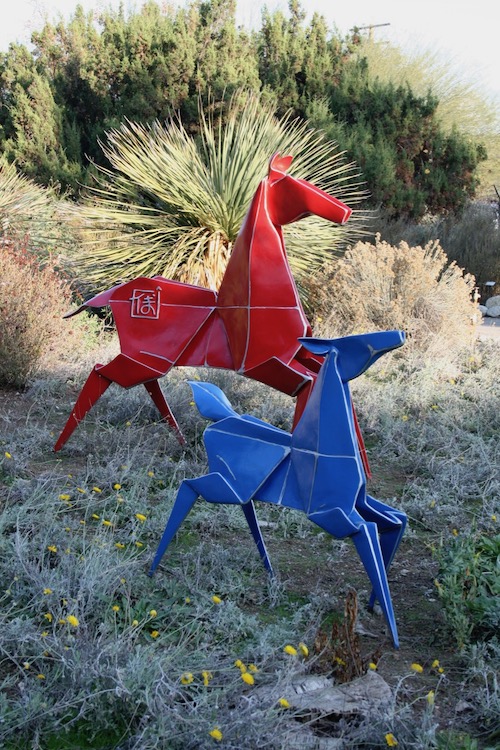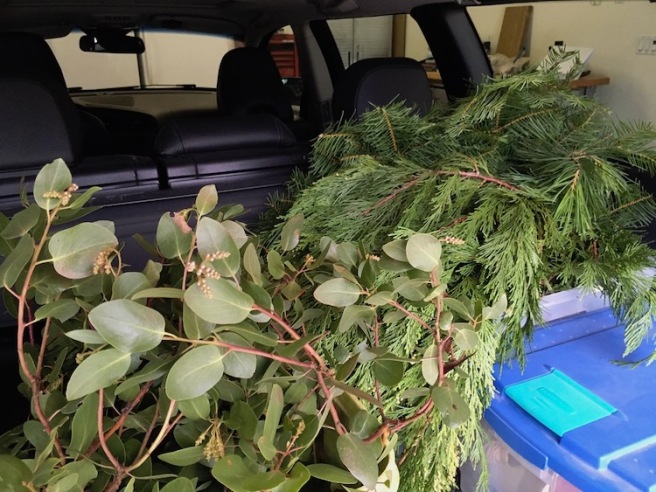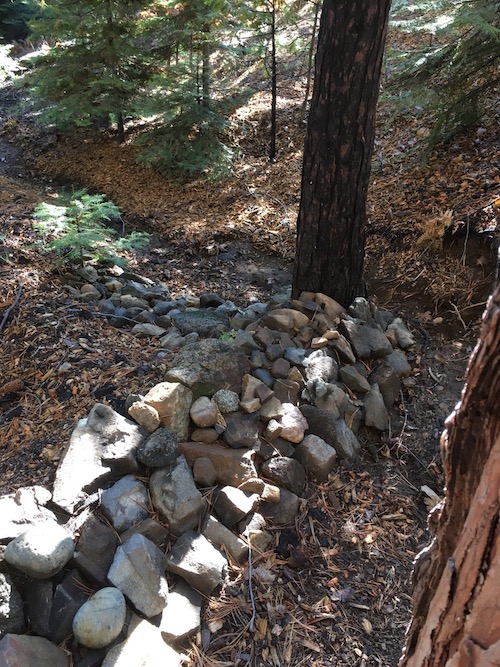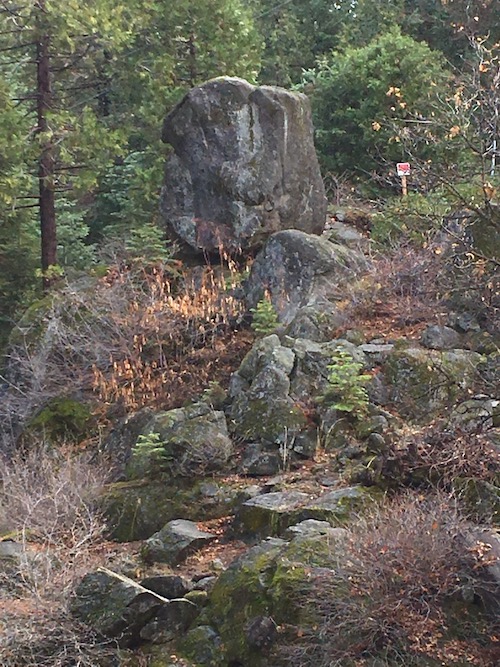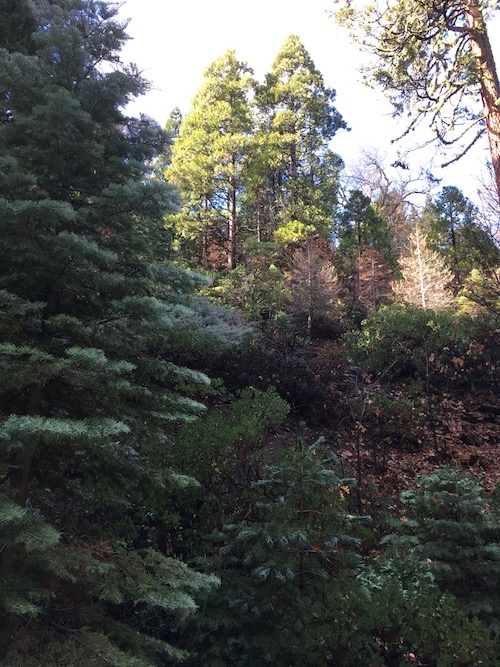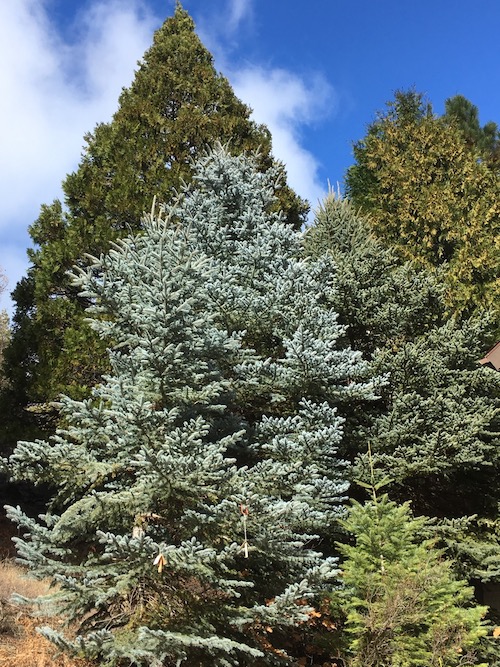Our so-far mild winter is allowing us to continue work on our final front yard lawn removal. We’ve had just the right amount of rain to loosen up the soil and make digging less onerous but not so much that we have lost too many work days to puddles, sogginess and sinkholes.

We are marching steadfastly from west to east with my sweet Dave in the lead, having both the tools and muscle. You can barely see him in this photo sitting on the ground behind the red wheelbarrow. This being our fourth time to the party he has got a pretty good system. The lawn was chemically treated in early fall–lawn removal by sod cutting machinery is not such a sure thing with a common bermuda lawn. The roots can be very deep and any small viable bits left behind will roar back as soon as growing conditions are right. I swear there have been viable bermuda roots found in fossils from prehistoric times!
He has divided the area into smaller, more workable sections. First, he uses a hula hoe to scrape off any above ground dead grass up into piles. To not sacrifice so much of our topsoil he then sifts through these piles, separating grass remains from viable soil–that’s is what he is doing sitting on the ground in the photo. The good soil is then moved off to a tarp to be reincorporated later. Next he tills the area and again picks out any grass roots, rocks, etc. including copious wads of the green netting that was the original sod’s underlayment. Step three is to double dig the section–one shovel depth’s down worth of soil is dug and off loaded to the side and then the newly exposed surface is dug a second shovel depth’s down. The rock, roots and various leftover construction material removal continues throughout the process. All the previously off loaded soil is returned to the bed and dug together along with whatever amendments I have selected for the area. I am exhausted just outlining the process! The last step is to grade the section to flow smoothly into large untouched areas at the bases of our mature trees.
As Dave prepares the beds I follow behind adding the plants. As with the areas already finished I am concentrating on more waterwise plants–hoping to create a balance the water needs of the existing mature landscape and the new. Unlike last year, my back yard holding area is not so flush with “plants in waiting” so planting is going slowly. Lots of bearded iris and daylily divisions have gone in along with a number of my favorite salvias. I am trying a few more new selections such as Cistus ‘Anne Palmer’ and Ceanothus ‘Hearstiorum’, both plantings of which will be in the bed’s ground zero for all day southern sun. Once these are established they should be very low water users which will allow me to eliminate several pesky, always broken, curbside sprinkler heads.
I am on always on the hunt for plants. Our recent Southern California overnight yielded two nursery stops and a few selections were checked off my acquisition list. Not to be found–and no surprise given the time of year–was another Salvia ‘Dara’s Choice’ to echo the one planted to the west of the front walk last year.

I probably should read my own blog archives so I can remember if ‘Dara’s Choice’ was purchased locally or, more likely, one of the salvias I bought at the San Luis Obispo Botanical Garden’s 2017 fall plant sale. The single gallon can specimen was quite small and unremarkable when planted but over the year it has grown to a beautifully shaped, slightly weepy mound with clear medium green quilted leaves. And in the last couple of weeks it has come into bloom. Not really a show stopper but not every plant has to be covered in big, blowsy flowers to have worth in my garden.

Mid photo you can see there are a good number of gracefully stalks bearing the small pale blue whorled blooms. The layered foliage performed very well, even though in the ground only a few months, throughout our very hot and dry 2018 summer. Its graceful appearance on the slope is worth repeating in the area we are now working. A little research reveals ‘Dara’s Choice’ to be one of the black sages, botanically Salvia mellifera. Apis mellifera is the scientific name for honeybees to which this plant is highly attractive. The foliage is wonderfully fragrant and its relatively low, mounding profile and broad spread makes it a great salvia selection for well-drained, sunny slopes. I am hopeful I will find one soon and who knows what other interesting plants I will meet along the way! Give us a few more weeks on this project for a complete coverage of what we’ve added to the mix of shrubs and perennials.




















